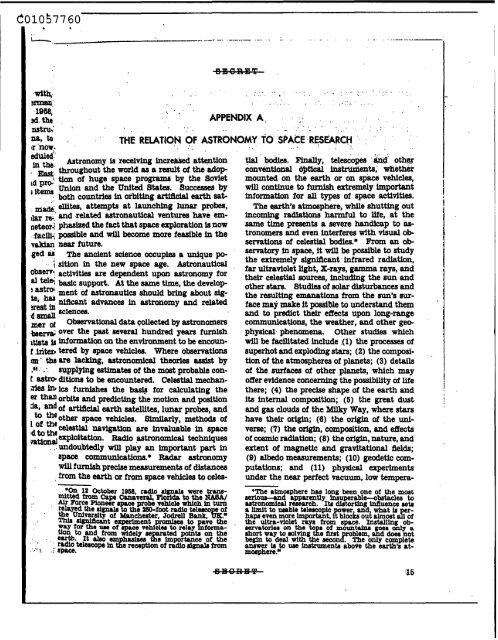4 - The Black Vault
4 - The Black Vault
4 - The Black Vault
You also want an ePaper? Increase the reach of your titles
YUMPU automatically turns print PDFs into web optimized ePapers that Google loves.
c010!57760<br />
b t<br />
L.<br />
. i . -_ .......... ......... ..... ._-___-<br />
with;<br />
-: ~lSs8,<br />
sd. the<br />
nstru;<br />
na, to<br />
or 'now.<br />
.._<br />
... . . . . . .<br />
..-<br />
. . . . . . . . . . . . . . . .<br />
... . ' ( . . . . .. .'.'. . "<br />
. . . . . . . .<br />
.<br />
.<br />
. ... ....<br />
, I . .<br />
'. ,<br />
APPENDIX A, . . .- 2 .<br />
. . . . .<br />
. . . ........<br />
. . . . . . . . . . .-. .<br />
... . .<br />
..<br />
THE RELATION OF ASTR;ONOMY.TO' SPACE.ReSEARCH .. : "<br />
hlxmomy s receiving increbkedattention<br />
,in the' throughout the world as a result of the adop<br />
-1 tion of huge space programs by the 8oviet<br />
Id prG union and the United States. Successes by<br />
1 item<br />
o both countries in orbiting artfficfal earth satmsdi.ellites,<br />
attempts at launching lunar probes,<br />
,m and related astronautical venturea have emnet&<br />
phasbed the fact that space exploration fs now<br />
facuj possible and will become more feeasible in the<br />
vakian near future.<br />
.ged sd <strong>The</strong> ancient science occupies a unique poi<br />
sition in the new space age. Astronautical<br />
Obw'~. activities are dependent upon astronomy for<br />
telq basic support. At the same time, the devdopment<br />
of astronautics should bring about sigh*<br />
niAcant advances in astronomy and related<br />
3rest<br />
d small<br />
in sciences.<br />
mer Observational data Collected by astronomers<br />
ohem Over the past 8cveral hundred years furnish<br />
lhb intormation on the environment to be encounr<br />
hifen tered by space vehicles. Where observations<br />
nn' theare lacking, astronomical theories sssist by<br />
.ab .- Supplyhg estimsteS of the most probable con-<br />
! astaw ditiona to be encountered. Celestial mechandes<br />
inr ics furnishes the bas@ for calculating the<br />
er than orbib and predicting the motion and position<br />
'a, and Of artificial earth satellites, lunar prow, aqd<br />
theother space vehicles. Bimilarly, methods of<br />
' Of *eceletstlal navigation are invaluable in space<br />
dtawqloitatim. ~sdio astronomical techniques<br />
m'*3'undoubkdly wUl play an important part in<br />
Space communications.* Radar astronomy<br />
will furnish precise measurements of distances<br />
from the earth or from space vehicles to celes-<br />
*On 12 October 1968, radio 8lgnala were trarurmittad<br />
from Cape Canaveral, Florida to the NABA/<br />
Air Force Pioneer I probe vehlcle which ln turn<br />
relayed the R e 1M)-foot radio telasco of<br />
the universltp oi bdancherter, ~~drell E- 6k.s<br />
Thh 8iigaincant experiment promkes to ave the<br />
way for the u# of rpace v ~dea to relay Lorma<br />
tlon to and from widely setg(vated points on th;<br />
- earth. It rlso em mixes e Importance of the<br />
radio telempe In +,Erscap+,ia of radio d m irom<br />
;*i : space.<br />
' ' ' ,<br />
, .<br />
tial bodiea. Flnally, telescopes bd other<br />
conventiaal 6ptIcal mtnmients, whether<br />
mounted on the earth or on space vehicles,<br />
will cmtlnue to furnlsh extremely important<br />
information for all types of space activities.<br />
<strong>The</strong> earth's atmosphere, while shutting out<br />
lncowg radiations harmful to life, at the<br />
same time presents a severe handicap to astronomers<br />
and even interferes with visual observations<br />
of celestial bodies.* From an observatory<br />
in space, it will be possible to study<br />
the extremely significant infrared radiation,<br />
far ultraviolet light, X-rays, gamma rays, and<br />
their celestial sources, including the sun and<br />
other stars. Studies of solar disturbances and<br />
the resulting emanations from the sun's surface<br />
may make it possible to understand them<br />
and to predlct their effects upon long-range<br />
communications, the weather, and other geo-<br />
physical phenomena. Other studies which<br />
wlll be facilitated include (1) the processes of<br />
superhot and exploding stars; (2) the compo&<br />
tion of the atmospheres of planets; (3) details<br />
of the surfaces of other planets, which may<br />
Mer evidence concerning the possibility of life<br />
there; (4) the precise shape of the earth and<br />
its internal composition; (5) the great dust !<br />
and gas clouds of the Milky Way, where stars<br />
have their origin; (6) the origin of the universe;<br />
(7) the origin, composition, and effects<br />
of cosmic radiation; (8) the origin, nature, and<br />
extent of magnetic and gravitational fields;<br />
(9) albedo measurements; (10) geodetic computations;<br />
and (11) physical experiments<br />
under the near perfect vacuum, low tempera-<br />
*<strong>The</strong> atmomhere ha8 long been one of the mat<br />
seriourcpnd apparently imuperablbobstacles to<br />
rrstronomical reaearch. It8 distorting influence seta<br />
a llmit to mble telescopic wer and what is erhaps<br />
even more important, pbl& out almost & of<br />
the ultra-violet ray8 from space. Indallfng oburvatorier<br />
on the to I of mountdm goes only a<br />
8hort way to solving &e flrst roblem, and does not<br />
begin to deal wlth the woon8. <strong>The</strong> only complete<br />
answer k to use instruments above the earth'# rtmo8phere."<br />
I

















